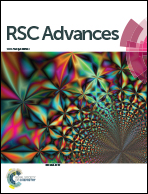Magic sol–gel silica films encapsulating hydrophobic and hydrophilic quantum dots for white-light-emission
Abstract
A sol–gel SiO2 film prepared from 3-aminopropyltrimethoxysilane (APS) has been developed as an excellent medium to encapsulate both hydrophobic and hydrophilic quantum dots (QDs). The film was fabricated by spin and dip coating on flat substrates as well as by a spraying approach on various substrates with a 3-dimensional (3D) surface. Pre-heat-treatment of the substrate plays an important role for creating homogeneous films on a 3D surface. In the case of aqueous CdTe and ZnSe0.9Te0.1 QDs, APS did not decrease the photoluminescence (PL) efficiency of the QDs. For hydrophobic QDs, a phase transfer from oil to water phase was first performed through the ligand exchange process between APS and the capping agent. By mixing QDs with different emitting colors, silica gel with white-light emission was obtained. Based on hydrophobic and hydrophilic QDs, white-light-emitting diodes with adjustable chromaticity coordinates were fabricated using a UV-emitting InGaN chip as excitation source. Because of the facile preparation procedure, high stability, and high PL efficiency, the magic film shows great potential for use in white-lighting-emission applications.


 Please wait while we load your content...
Please wait while we load your content...